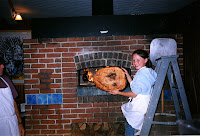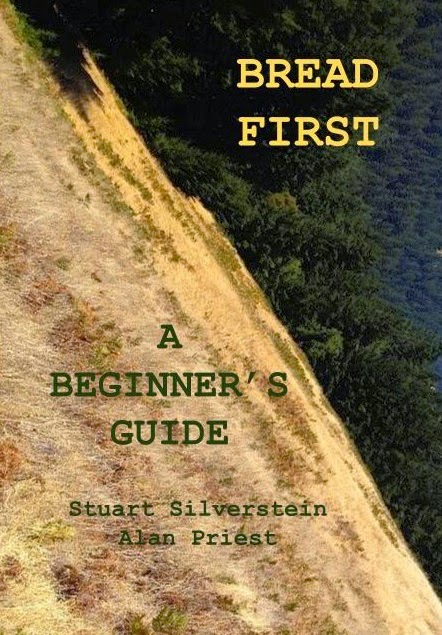Saturday, December 26, 2009
Bake Door Update
Hemp For Fuel
Any way you look at (and we all need to), burning wood creates a lot of air pollution and contributes to deforestation. I love my outdoor wood-burning oven as much as anybody loves theirs, but every time I see the smoke it produces, not only do I feel a little sense of guilt, but I also wonder about fuel alternatives.
Perhaps hemp is one of the answers. I don't know how many BTU's it puts out, and I don't know how much air pollution it produces, but I do know that it's well past the time we started to look beyond firing our ovens with wood.
There is a company in England that sells Rastafire Logs, and that's no joke.
Wednesday, December 9, 2009
Who Owns The Wind?
One of the most interesting and yet incredibly bizarre books about bread I've ever looked at is H.E. Jacob's, Six Thousand Years Of Bread.
For example, in one small section, Jacob talks about some monks who wished to build a windmill for the purpose of grinding grain (could there be any other purpose?).
However, there was a count who ruled against it because he said the wind passed over his land and therefore the wind belonged to him! Ultimately the monks were allowed to construct their windmill, but they had to pay a yearly tax to the count for the privilege of using his wind. They were not pleased.
I think we can be certain that those who battle against clean energy (and you know who they are) would think highly of the count's tactics and are searching for ways to prolong the burning of fossil fuels.
Friday, December 4, 2009
Bread baking workshop
Hello all,
Wednesday, December 2, 2009
Fire Door Update
I've adjusted my fire door by cutting a slot in the bottom. I can restrict or increase the airflow by sliding the two bricks shown in the photo. This arrangement does improve fire management, but I was hoping to get the blowtorch/freight train sound when I started the fire. This will probably not happen unless I add a chimney, and that I won't do.
Sunday, November 29, 2009
Fire Starter
I have two doors for my oven. One door is made of wood, but has a steel backing (see earlier post), and this is used after the fire is out. The door is then set in place when baking bread.
The other door, that I just adapted today is used while the fire is burning. What I did was to cut the top of the door, but I left a space at the bottom of the door so that when it sits on the hearth, it doesn't sit on it completely.
So, there's a large space at the top of the door for exhausting the smoke and a small space at the bottom for constricting the flow of oxygen that the fire is calling for. This definitely makes it easier to start and maintain a fire. I believe this is called The Venturi effect.
For the scientifically minded, the Venturi effect is a special case of the Bernoulli effect, in the case of fluid or air flow through a tube or pipe with a constriction in it. The fluid must speed up in the restriction, reducing its pressure and producing a partial vacuum via the Bernoulli effect. It is named after the Italian physicist Giovanni Battista Venturi.
Without a door like this, the fire seems to be buffeted from all sides and does not burn as well.
The two bricks in front of the door are there to keep the door in place.
Wednesday, November 25, 2009
Pushing It To The Limit
In my last post I showed a resurrected loaf that only minutes before was a charred wreck. Often it's possible to weasel out of difficult situations, but if those situations never present themselves, then in my opinion I'm really not exploring my full potential as an oven builder/bread baker. To arrive at a place that I am comfortable with, I'll never know where that is unless I push myself to extremes. For example, how hot can I get my oven so that I can do multiple bakes without burning to a crisp the first batch of bread. Well, I really won't know until I burn a few loaves.
Once when building an oven, I first added way too much clay to my mix, and the oven really developed horrible cracks. I tore it down even before I removed the sand mold, and built it right the second time.
Last summer, in the middle of a workshop I was giving I had an oven totally collapse because there was was too much sand added to the mix. Sure, I should have been more attentive, but I wasn't. Miraculously, in one hour, we reformed the sand mold and rebuilt the oven with the correct proportions of clay to sand. And one hour after that (no joke), we were baking pizza in the oven.
When making sourdough bread, sometimes I might be unsure of how much starter to add. I might try a tiny amount and then try a humongous amount. If I don't push it to the extreme I'll never know what the limitations or the exciting possibilities really are.
Yes, I could engineer my breads as professional bakers must do, because they are very concerned about consistency since they sell their product, but for me, being an amateur can be much more rewarding. That's the place where I want to be. I have no one to answer to, and every new bread I bake becomes, really, a quest for the grail.
After all these years, I still believe that Dylan had it right. "There's no success like failure and failure is no success at all."
Just stay with it, and don't worry about making mistakes. It's all going to work out.
Look at the photo of the bicyclist. He's not afraid to take chances, but does he know what will happen if he adds just one more box?
Monday, November 23, 2009
Saturday, November 21, 2009
Oven Door
Without the air space, the intense oven heat could conduct right through the steel and turn my proud. new oven door into charcoal. The wooden door is the door I use for bread baking.
When starting my fires up I use an all steel door that I prop slightly open. This restricts the flow of oxygen, creating a vortex effect, making it easier for the fire to burn.
Tuesday, November 17, 2009
More No Knead Again
Probably you have all you need already. I've even made insulated cookie sheets by doubling up single wall sheets, leaving an airspace. The one shown came as a Chanukah present. Yes, it's better than the one I made.
Monday, November 16, 2009
More No Knead
Monday, November 9, 2009
No Knead Mythology
 Mark Bittman's video of Jim Lahey's method of making no knead breads has been seen on YouTube over 532,753 times. Right at the beginning of the video Jim says even a four year old can make bread with his techinque. If you're like me, I tend to believe what people tell me unless I have reason to believe otherwise. Hey, if a four year old can do it, then surely I can, and that's what I suspect most people thought who saw the video.
Mark Bittman's video of Jim Lahey's method of making no knead breads has been seen on YouTube over 532,753 times. Right at the beginning of the video Jim says even a four year old can make bread with his techinque. If you're like me, I tend to believe what people tell me unless I have reason to believe otherwise. Hey, if a four year old can do it, then surely I can, and that's what I suspect most people thought who saw the video.The reality is, a four year old cannot make this bread, and I'm willing to bet that when most bakers tried this technique, they were initially disappointed, but were too embarrassed to admit that they could not do something that ostensibly a child would have no problem doing.
The no-knead bread is not a simple bread to make. In fact it's quite a bit more difficult to make than a standard yeasted bread where you knead the dough. Here's the problem: The no-knead dough is a very slack (wet) dough, and this type of dough can be so difficult to work with that you might very well find a slimy mess on your counter that is impossible to handle. That was my first experience, and when I finally was able to dump the dough in the hot iron pot, I didn't realize that it would stick hopelessly to the bottom of the pot.
My problem was that I followed Jim Lahey's instructions in the video, and I followed them to the letter. I should have known better than to follow explicit instructions. In fact, I've been telling folks for years not to follow explicit instructions.
First off, he says to use three cups of flour. When you scoop flour, as he does, you don't really know what you're getting. The only way to really know the honest amount is to weigh the flour. If you don't have a scale, then you have to go by observation and feel, and that's okay. In fact, that's what I usually do, but remember, I needed to prove to myself I could do what a four year old could do.
The video shows the dough being dumped on the counter, and then soon after, the dough is being formed up. Wait a minute here. Certainly more flour was worked in to make this possible, but we don't see it.
I also noticed that the iron pot Jim Lahey was using was sitting on a cookie sheet in the oven. The cookie sheet will deflect some of the oven heat away from the bottom of the loaf, helping to prevent the bottom from burning. Maybe people should be told these things.
Monday, October 19, 2009
No Knead Bread Revisited
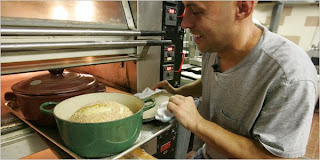 Mark Bitman's video of his visit to Jim Lahey's Sullivan Street Bakery has been viewed over a half million times. I have looked at the video several times, but I was not able to achieve the results shown, and now I think I have figured out why. After Jim dumps out the dough on his work table, the video is edited, and suddenly he's forming and shaping the dough. Sorry, but you just can't shape such shaggy dough without an intermediate step. My feeling is that what you don't see is extremely relevant. I suspect the shaggy dough is rolled around with flour until it firms up enough to shape. The story in the New York Times also talks about a two hour rest period, but this is never mentioned in the video. To make this excellent bread, you really need to have all of the information. The recipe calls for three cups of flour, but I think you might have better results with three and one half cups.
Mark Bitman's video of his visit to Jim Lahey's Sullivan Street Bakery has been viewed over a half million times. I have looked at the video several times, but I was not able to achieve the results shown, and now I think I have figured out why. After Jim dumps out the dough on his work table, the video is edited, and suddenly he's forming and shaping the dough. Sorry, but you just can't shape such shaggy dough without an intermediate step. My feeling is that what you don't see is extremely relevant. I suspect the shaggy dough is rolled around with flour until it firms up enough to shape. The story in the New York Times also talks about a two hour rest period, but this is never mentioned in the video. To make this excellent bread, you really need to have all of the information. The recipe calls for three cups of flour, but I think you might have better results with three and one half cups.
Tuesday, October 13, 2009
Steam
To get a good crust on your breads made in an earth oven, you need steam. A fully loaded oven with breads might create enough steam all by themselves, but the easiest way to make steam is with a sprayer. The little $1.00-$2.00 hand sprayers won't do it. You'll have to invest at least $12.00 for one that will put out the volume required. These are the ones you have to pump up and are sold in garden supply stores. I sent to Amazon for mine. Only a fool would use a sprayer that once held herbicides and/or pesticides, so I won't tell you not to use one of these.
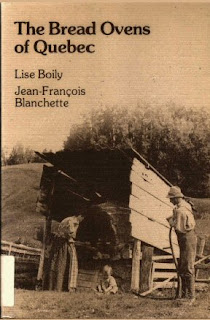
I just learned that anyone can download a free version of The Bread Ovens of Quebec. If you don't have a hard copy and can't find one, then I highly recommend the electronic version.
Sunday, September 27, 2009
Apple Crisp
Saturday, September 19, 2009
Thursday, August 27, 2009
Earth Oven Form
Most folks use a simple sand mold.
Tuesday, August 25, 2009
Hot Pants
Spraying the oven interior also helps, but in this case, I did both.
Sunday, August 23, 2009
Get It Hot
How hot? The oven floor where you'll be baking should be about 650 degrees. How will you know the temperature? Well, easiest way is with an infrared thermometer with laser. I bought a Mastercool from Amazon for about $35.00, and they even give you a case and a dial thermometer.
If your oven is not hot and fiery, your pizzas will not bake properly.
Saturday, August 22, 2009
Siting the pizza oven
Pizza parties are great fun, but often the baker feels left out. The reason for this is most likely a poor layout. Often, the baker is working far from where folks are visiting.
Here's what I suggest. Have work tables right next to the oven. Making pizza takes lots of work surface. Have chairs within ten feet of the oven. If everything is not clustered by the oven, you, the hapless baker will not find helpers, and you'll have nobody to visit with while you're working.
Don't just plunk your oven down anywhere. Do your site design first.
Saturday, August 8, 2009
Flat Breads Without Oven
Saturday, August 1, 2009
Baking With The Little Ones
Friday, July 31, 2009
When Disaster Strikes
 Yes, it was my fault. I had allowed too much sand to be mixed in with the clay, and you can see the result. But there is a happy ending. The courageous participants in the workshop wanted to rebuild (I felt like jumping in the river), and we started again. In only one hour we rebuilt the oven,
Yes, it was my fault. I had allowed too much sand to be mixed in with the clay, and you can see the result. But there is a happy ending. The courageous participants in the workshop wanted to rebuild (I felt like jumping in the river), and we started again. In only one hour we rebuilt the oven, Tuesday, July 21, 2009
Earth Furniture
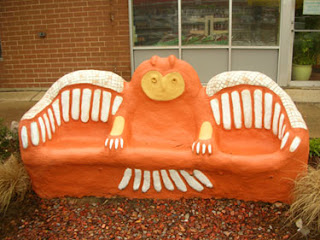
If you've already built an earth oven or perhaps you prefer to do something different with mud, then consider this elemental substance for constructing furniture.
Check out Miguel Elliott's beautiful website for lots of ideas, and be sure to watch the videos.
Sunday, July 5, 2009
Pizza Workshop For Kids
